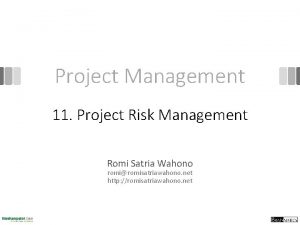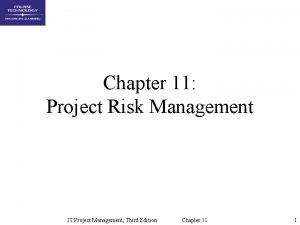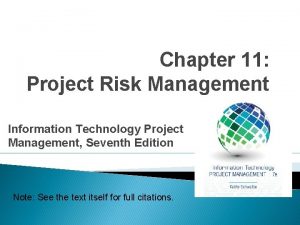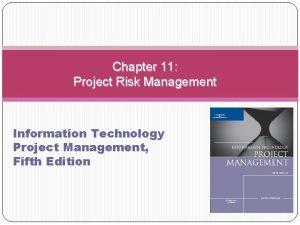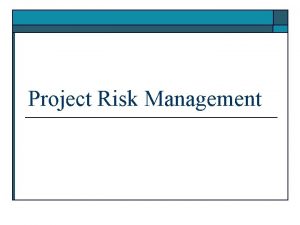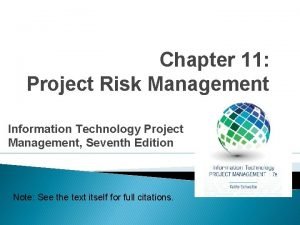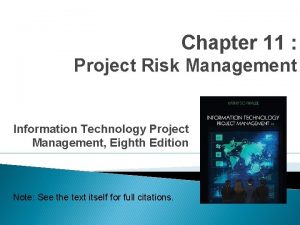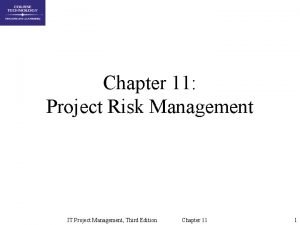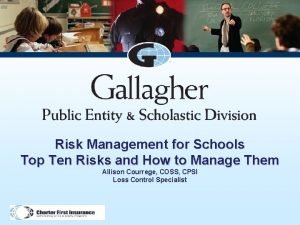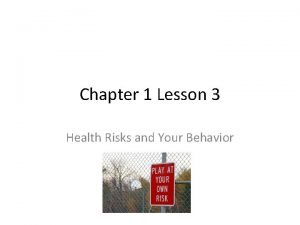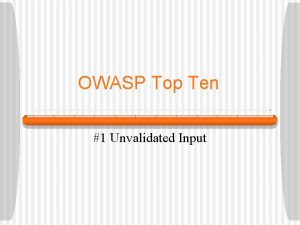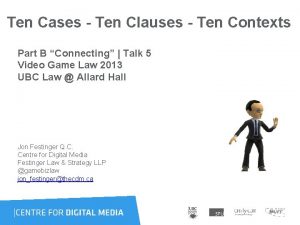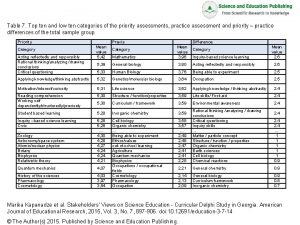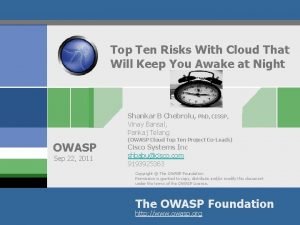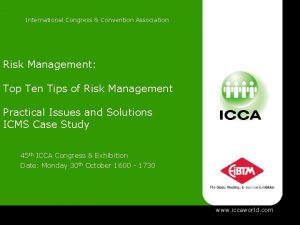Risk Management for Schools Top Ten Risks and

























- Slides: 25

Risk Management for Schools Top Ten Risks and How to Manage Them Allison Courrege, COSS, CPSI Loss Control Specialist

Points for Discussion q q q School Risk Management Top 10 Charter School Risks- Your Exposures Trending Losses Steps to Managing School Risk How to Transfer your Risk q Buy Insurance q Ask for Certificates of Insurance from Vendors q Just say “no” 2

School Risk Management • A method of managing school activities to minimize losses and liability – Reduce hazards – Reduce risks in school activities – Improve safety for students, employees, and the public – Conserve the schools financial resources (Insurance – risk transfer) – Protect board, staff from liability 3

Risk Management Techniques • Avoid the Risk- “Just say No”. • Transfer Risk: Insurance, hold harmless agreements • Reduce the Risk: Accountability and Risk Assessment activities, Safety committee 4

What are your Schools Top 10 Risks? 5

What are a Schools Top 10 Risks? • • • Premise Medical/General Liability Employment Practices Vehicle Accidents Workers Compensation Stolen Laptops/Equipment • • Drop-off/Pickup Playground – Athletics Field trips/Foreign Travel Special Education • Crisis Event/Student Violence 6

Steps to Managing Risks • • • Accountability- Ownership from Administration and Staff Form a Safety Committee Develop a written Safety Program and Action Plan Conduct a Risk Assessment of the School (address all risks) Implement Plans to address exposures: – – – Identify higher risk exposures and implement controls Employment Practices Vehicle Safety Program- Field Trips Sexual Harassment and Abuse Risk Management School Inspection Program Education Board and Staff 7

Premise Medical- General Liability, Workers Compensation • • Be proactive about your exposures Attention to detail and housekeeping Implement informal and formal inspection program Evaluate Risks with use of your safety committee Create Action Plans – short and long term Utilize outside specialists when needed: – Playground, Athletic Equipment – Gym – Chemistry labs – Food Service (contracted vs. own employees) – Drop-off / Pickup Employee Training for workers compensation issues 8

Employment Practices • Understand the exposure – Harassment, Discrimination, Wrongful Termination • • • Make informed decisions (No lone Rangers) Manager Training Follow Policies carefully Document……Document…. . Document Appropriate HR/Legal Partner in-house or external 9

Vehicles - Transportation • • • School drivers - School-owned vehicles School leased or chartered buses, vehicles or vans Transportation is sole responsibility of parent/guardian or adult student School employees or volunteers driving personal vehicles Students driving students is NEVER recommended Bus/Van drivers: need CDL’s, MVR’s, Fit Testing 10

Laptop Security • • • Dedicated computer storage room Storage Carts Alarms Key Control & Limiting Access Nightly Storage Physical Appearance Tracking System – check in, check out procedure Laptop Configuration By the way…. we are still having losses! 11

School Access and Security • • • Visitors use designated entrance (s) Visitors sign in and out, and photo-ID is presented and copied Visitors wear a badge/pass which is clearly visible & identifiable Visitors are met by an employee & stay with them throughout their visit “No entry” signs are posted where needed “Staff only” signs are posted where needed 12

Evaluating Special Activities • What Type of Activity is This? – Field Trip – School Sponsored Activity – School Co-Sponsored Activity – Non-School Sponsored Activity – Student Body Organizations – Booster Club Activities 13

Field Trips • • • Educational Value vs. School Exposure Written Policies/Procedures/Rules Field Trip Checklist – Approval process/timeline, required forms – Method of insuring parent approval including • Authorization for Emergency Medical Treatment • Location of forms: with the supervisors • Screening of supervisors; chaperones 14

Field Trip Forms • • • Student Field Trip Form - Assumption of Risk, Voluntary Activity & Hold Harmless Medical Treatment Authorization Adult Student Form Volunteer Form Out of State Trip 15

Non-School Sponsored Activities • Grad Nites (Nights), Week-End Camping Trips, Overseas Travel • Notice to Parents • Transportation/Supervision Disclaimer • Parent Acknowledgement • Disassociate the School: logos, equipment • Prohibit use of class time 16

What is a Crisis? • • • It’s really anything out of the ordinary! Earthquake / Storm / Police Activity / Fight at school? Students and/or parents with weapon(s) Hazardous Material leak / gas leak / explosion School bus accident / van accident Food poisoning in the cafeteria / field trip Lost Student Death of a student, staff, or faculty member Flood / broken water main FIRE! 17

The First 30 Minutes… • • • Understand the circumstances – do NOT speculate! Call for help! 911 or whatever is needed Assign the appropriate person(s) to handle the situation Notify the Administrative offices (Board members also) Define the problem(s) & consider all options Communicate with staff/faculty/students/parents Secure the area/building/campus Set up a command post “Incident Command” situation 18

The next 30 minutes… • • • REGAIN CONTROL! Document everything – assign a scribe Communicate with the media – if necessary Update the students in the classrooms – not in large settings Consider closing the school? If so, arrange for transportation & notify the local police department Contact “crisis counselors” and have them respond 19

The rest of the day… • • Document, document Inform parents by a letter sent home If a crisis team was set up – note their role and followup Disseminate accurate information Post information about the incident on your webpage and your telephone “hot line”…Update frequently Ensure that the school board has been notified Visit the injured / wounded in the hospital(s) 20

Then… • • • Take the students/staff through the crisis and debrief Offer professional counseling to everyone involved – Faculty, staff, students, aides Make the decision when to reopen the school – make this decision as soon as possible. Hold an open house for parents and students Don’t forget the “incident”, but MOVE ON ALSO… 21

Crisis Management Plan • • Team Members – Chain – of – command (in case principal is absent) – Names, addresses, phone #’s, page, cell phone – Normal assignment – if a classroom teacher/name of substitute – Assignment during a crisis Important telephone numbers – Fire / rescue – Police, sheriff – Local hospital emergency room – News/media – Crisis counselors 22

Plan continued… • • • CODE RED procedures • LOCKDOWN procedures Types of Emergencies. • – Assaults / serious personal injury – Bomb threats – Child napping – Explosion, fire – Weapons, suicide, sex • offenses – Riot , Hostage situation, intruders – Natural disaster Media Procedures Evacuation Plan – Quarterly Drills, floor warden, written plans – Alternate site, plan for transporting students Local EMS can help 23

Transfer Risk -Types of Insurance • • Commercial General Liability Property Insurance Automobile Liability Employment Practices Directors & Officers – Errors & Omissions Workers’ Compensation Student Accident Insurance – Just to name a few! 24

Questions? Allison Courrege, COSS, CPSI Arthur J. Gallagher Risk Management Services, Inc. Phone: 225 -906 -0146 E-mail: allison_courrege@ajg. com Jill Couvillon, ARM Arthur J. Gallagher Risk Management Services, Inc. Phone: 225 -906 -1222 E-mail: jill_couvillon@ajg. com 25
 Top ten risk item tracking
Top ten risk item tracking Figure 11-4
Figure 11-4 Top ten risk item tracking
Top ten risk item tracking Expected monetary value
Expected monetary value Top ten risk item tracking
Top ten risk item tracking Top ten risk item tracking
Top ten risk item tracking Top ten risk item tracking
Top ten risk item tracking Top ten risk item tracking
Top ten risk item tracking Top ten risk item tracking
Top ten risk item tracking Managing risks in schools
Managing risks in schools Owasp top 10 privacy risks
Owasp top 10 privacy risks Market risk assessment
Market risk assessment The biggest risk is not taking any risk
The biggest risk is not taking any risk Related risks that increase in effect with each added risk
Related risks that increase in effect with each added risk Top management middle management first line management
Top management middle management first line management Top management middle management first line management
Top management middle management first line management Top management middle management first line management
Top management middle management first line management Safety reach target
Safety reach target Huntsville city school powerschool
Huntsville city school powerschool Ten twenty thirty worksheet
Ten twenty thirty worksheet Ten ten siempre fuerzas y esperanza
Ten ten siempre fuerzas y esperanza Am i a 10/10
Am i a 10/10 Key risk indicators template
Key risk indicators template Risk map
Risk map Cash management risk assessment
Cash management risk assessment Unvalidated input
Unvalidated input
